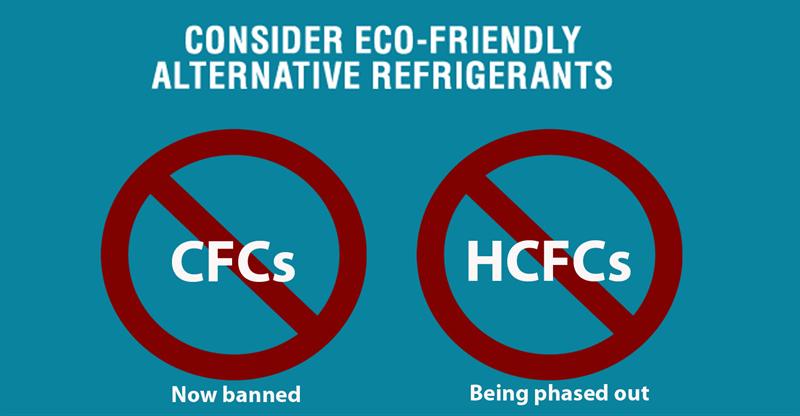Courtesy : en.wikipedia.org
Cfc reduction
Chlorofluorocarbons (CFCs) and hydrochlorofluorocarbons (HCFCs) are fully or partly halogenated hydrocarbons that contain carbon (C), hydrogen (H), chlorine (Cl), and fluorine (F), produced as volatile derivatives of methane, ethane, and propane. They are also commonly known by the DuPont brand name Freon.
The most common representative is dichlorodifluoromethane (R-12 or Freon-12). Many CFCs have been widely used as refrigerants, propellants (in aerosol applications), and solvents. Because CFCs contribute to ozone depletion in the upper atmosphere, the manufacture of such compounds has been phased out under the Montreal Protocol, and they are being replaced with other products such as hydrofluorocarbons (HFCs)[ including R-410A and R-134a.
Structure, properties and production
Main article: Organofluorine chemistry
As in simpler alkanes, carbon in the CFCs bond with tetrahedral symmetry. Because the fluorine and chlorine atoms differ greatly in size and effective charge from hydrogen and from each other, the methane-derived CFCs deviate from perfect tetrahedral symmetry.
The physical properties of CFCs and HCFCs are tunable by changes in the number and identity of the halogen atoms. In general, they are volatile but less so than their parent alkanes. The decreased volatility is attributed to the molecular polarity induced by the halides, which induces intermolecular interactions. Thus, methane boils at −161 °C whereas the fluoromethanes boil between −51.7 (CF2H2) and −128 °C (CF4). The CFCs have still higher boiling points because the chloride is even more polarizable than fluoride. Because of their polarity, the CFCs are useful solvents, and their boiling points make them suitable as refrigerants. The CFCs are far less flammable than methane, in part because they contain fewer C-H bonds and in part because, in the case of the chlorides and bromides, the released halides quench the free radicals that sustain flames.
The densities of CFCs are higher than their corresponding alkanes. In general, the density of these compounds correlates with the number of chlorides.
CFCs and HCFCs are usually produced by halogen exchange starting from chlorinated methanes and ethanes. Illustrative is the synthesis of chlorodifluoromethane from chloroform:HCCl3 + 2 HF → HCF2Cl + 2 HCl
Brominated derivatives are generated by free-radical reactions of hydrochlorofluorocarbons, replacing C-H bonds with C-Br bonds. The production of the anesthetic 2-bromo-2-chloro-1,1,1-trifluoroethane (“halothane”) is illustrative:CF3CH2Cl + Br2 → CF3CHBrCl + HBr
Applications
CFCs and HCFCs are used in various applications because of their low toxicity, reactivity and flammability. Every permutation of fluorine, chlorine and hydrogen based on methane and ethane has been examined and most have been commercialized. Furthermore, many examples are known for higher numbers of carbon as well as related compounds containing bromine. Uses include refrigerants, blowing agents, aerosol propellants in medicinal applications, and degreasing solvents.
Billions of kilograms of chlorodifluoromethane are produced annually as a precursor to tetrafluoroethylene, the monomer that is converted into Teflon.
Classes of compounds, nomenclature
- Chlorofluorocarbons (CFCs): when derived from methane and ethane these compounds have the formulae CClmF4−m and C2ClmF6−m, where m is nonzero.
- Hydro-chlorofluorocarbons (HCFCs): when derived from methane and ethane these compounds have the formula CClmFnH4−m−n and C2ClxFyH6−x−y, where m, n, x, and y are nonzero.
- and bromofluorocarbons have formulae similar to the CFCs and HCFCs but also include bromine.
- Hydrofluorocarbons (HFCs): when derived from methane, ethane, propane, and butane, these compounds have the respective formulae CFmH4−m, C2FmH6−m, C3FmH8−m, and C4FmH10−m, where m is nonzero.
Numbering system
Main article: Refrigerant § Refrigerants by class and R-number
A special numbering system is to be used for fluorinated alkanes, prefixed with Freon-, R-, CFC- and HCFC-, where the rightmost value indicates the number of fluorine atoms, the next value to the left is the number of hydrogen atoms plus 1, and the next value to the left is the number of carbon atoms less one (zeroes are not stated), and the remaining atoms are chlorine.
Freon-12, for example, indicates a methane derivative (only two numbers) containing two fluorine atoms (the second 2) and no hydrogen (1-1=0). It is therefore CCl2F2.
Another equation that can be applied to get the correct molecular formula of the CFC/R/Freon class compounds is this to take the numbering and add 90 to it. The resulting value will give the number of carbons as the first numeral, the second numeral gives the number of hydrogen atoms, and the third numeral gives the number of fluorine atoms. The rest of the unaccounted carbon bonds are occupied by chlorine atoms. The value of this equation is always a three figure number. An easy example is that of CFC-12, which gives: 90+12=102 -> 1 carbon, 0 hydrogens, 2 fluorine atoms, and hence 2 chlorine atoms resulting in CCl2F2. The main advantage of this method of deducing the molecular composition in comparison with the method described in the paragraph above is that it gives the number of carbon atoms of the molecule.



